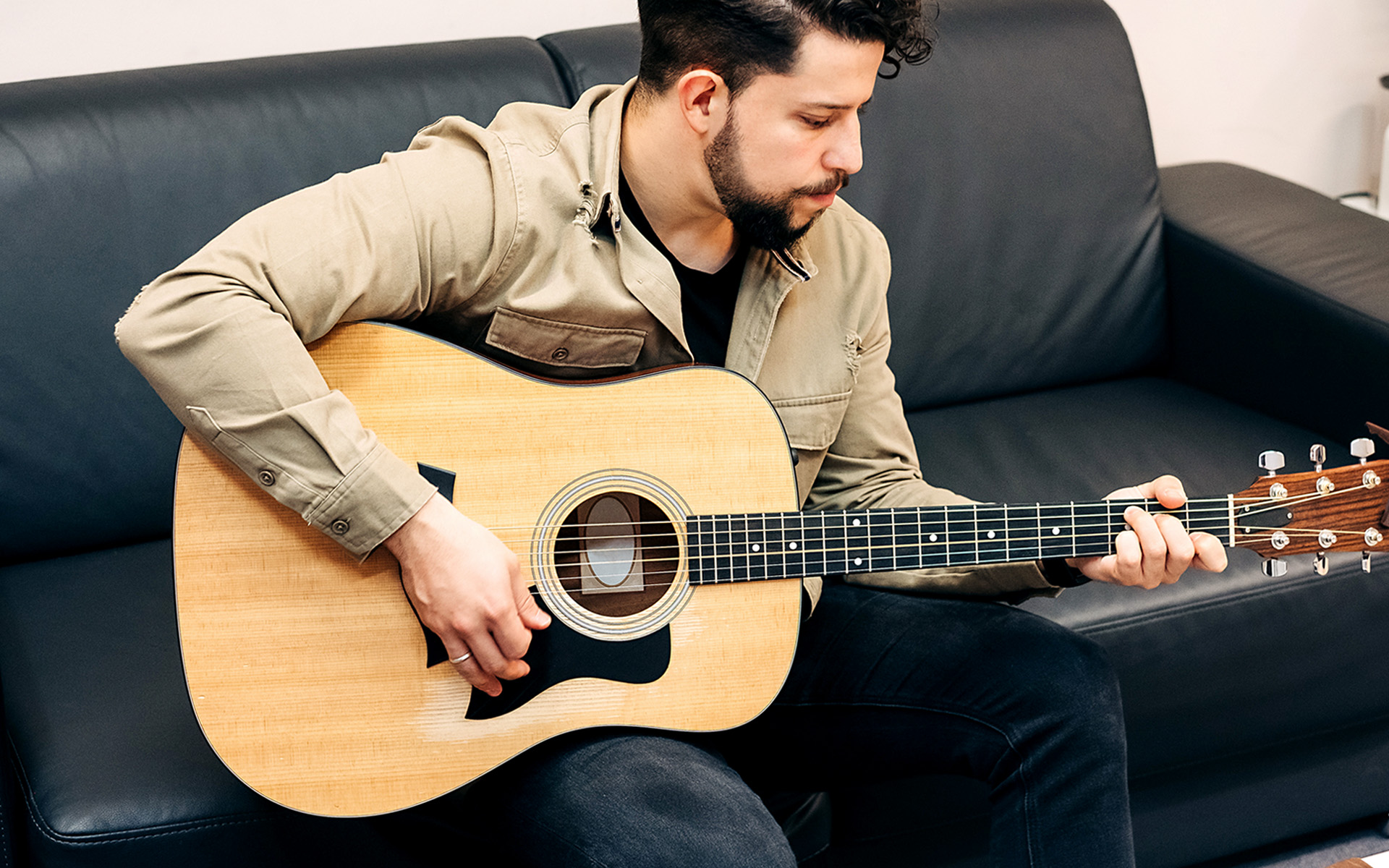Discover Songwriting Techniques That Transform Ordinary Chord Progressions Into Fresh and Expressive Music
We know a great chord progression when we hear it. We shush our loved ones over it, wade through mind-numbing verses to get to it, and try to lure these progressions out with a guitar in our skivvies at 2 in the morning. For the everyday songwriter, great chord progressions are rare gems buried just under the surface. We know they’re there. We know because other songs have them. They make crowns out of them.
Chords are a driving element of many songs. When we’ve got four elements of songwriting to manipulate (melody, chords, lyrics, and groove), it’s natural to credit them or blame them for a successful song. But how do we songwriters find and use great chord progressions? Is the answer to delve deep into music theory? If it is, are we fated to forever feel stuck if we don’t crack the chord code? I’d like to offer specific tools that songwriters—not composers, arrangers, or jazz harmony graduate students—use to write songs, using a richer chord vocabulary.
Music theory is a powerful tool, but it’s not the answer for everyone.
Having a healthy understanding of basic theory can make identifying chord progressions in other songs quicker and easier. It can enrich our feeling for utilizing new chords and pushing the envelope as we understand the function of our chords in the broader context of the progression. But writing is more than a theoretical process, and so theory is a tool like any other learned skill to inform and guide our natural creativity. Furthermore, theory just isn’t everybody’s cup of tea. Without the motivation to get a strong handle on it or an innate sense for how music flows, most writers never get to the point where theory knowledge is a useful tool. But by all means go ahead, be the exception.
For some basic theory for songwriters, check out my book, Beginning Songwriting, available on Amazon.
I believe the secret for songwriters looking to harness the power of chords lies in the answer to this question: What are specific tools songwriters use to break the monotony of our standard chord progressions? To answer this question, we need to look individually at what is happening in our writing process when we’re dissatisfied with our chord progressions.
TAKE A SONGWRITING COURSE WITH ANDREA STOLPE
1. We gravitate towards the same chords and the same keys.
When we’re tired of what we’re creating, it means we’re aware that what we’re creating is a recreation of what we’ve already created. Or said without redundancy: we’re copying ourselves. Pat yourself on the back because that means you’ve grown. You’re no longer satisfied with the status quo. But don’t stop there. Make some concrete changes to encourage a new direction. A few of the changes songwriters can make are:
Choose a New Key to Write In
This might mean a capo on the guitar, a new tuning, or switching over from major keys to minor keys. It might just mean writing in the key of Db when you typically write in D major or G major.
Start on a New Chord
This means being aware of the fact that we may typically start a verse or chorus on the tonic. Or perhaps we start on the vi minor and move to the IV chord. Whatever the tendency, the earlier in the section we break the pattern, the easier it will be to hear a pull towards something different.
Change the Tempo
Instead of that middle-of-the-road strumming pattern, we can slow way down or speed way up. This jars the brain, and we no longer have assumptions for how the song is going to progress. If we re-imagine the song early on, it inspires some new chord progressions too.
2. We try to involve new chords like our favorite songs do, but we end up sounding like a copy of the original.
I remember a time before I had written my first 150 songs when I struggled with feeling ordinary. The fact is, I was. Pretty much everything I wrote was heavily influenced by those who came before me. The secret was to finish songs, and not dwell too long on the writing of any particular one, so that I could feel in my mind and my fingers what it’s like to emulate lots of different grooves, melodic shapes, and lyric lines.
I’ve got my Sheryl Crow songs, my Sting songs, my Coldplay songs. I’ve even got my songs-that-people-say-are-Broadway. It’s okay. Stepping back, I can see them as threads in the tapestry of my sound. It’s not clear by looking at any one thread what characterizes my music. Weave them all together though, and that’s where the originality emerges. Lucky songwriters, or resourceful ones, find collaborators and producers who can identify and augment that thread.
3. We write a lot of little sections of songs and then can’t find a chord progression to follow them.
The trouble here can come down to contrast. A few simple tools to help with this problem are illustrated beautifully in John Mayer’s tune “Daughters.”
Keep the Chords, Change the Frequency
The verse of “Daughters” has four chords. And for a guy who can play every chord in existence, this verse is as simple as it gets. With one chord per measure, we hear a vi followed by a ii, then a V and the I. In 6/8 time, the whole verse is just four revolutions of this progression.
What’s remarkable is the energy and contrast he’s able to bring to the chorus with merely one new chord. He switches out the ii chord for the II chord, a borrowed chord. But there’s one other tool that’s even more important than the kind of chords he’s playing: the frequency with which he changes chords. This tool is so simple, and so overlooked by songwriters. In the chorus of “Daughters,” the chords change two times per measure instead of just once like they did in the verse. Try this tool in your own writing. Instead of searching for a brand new chord, try simply using the same chord progression and changing chords more or less frequently than you did in the prior section.
Find a Borrowed Chord
Borrowed chords are those that don’t belong to the key you’re writing in. To identify the chords in the key you’re writing in, you’ll need a bit of theory. I’m sure there is even an app out there you can input your chords into and it will tell you the key. Once you’ve got the key, you can move on to finding a few borrow chords.
Borrowed chords should be used sparingly and with intention. Too many and they hijack the song to make it all about them. But used at the right moment, they create a beautiful moment for the section and add meaning and emphasis to a lyric line. In a mostly diatonic progression, try the simple action of switching out a major chord for its minor, i.e. instead of A major, play an A minor chord. A favorite song of mine that utilizes a simple borrowed chord switch is “Crazy” by Gnarls Barkley. They play with the i suddenly becoming a I and then it switches back again. It’s a moment in the song where the shadow of a minor suddenly brightens under the effect of a major chord.
One very common borrowed chord to try at the end of a pre-chorus or chorus is the II in place of the ii chord. It signals to the listener that something important is just around the corner: either the first line of the chorus, or the last line.
I recommend writing a whole song around just one borrowed chord in a progression. Get the sound of that borrowed chord and its potential to highlight the lyric and create a musical moment under your belt. Then write another song with the use of a different borrowed chord. The key for songwriters is to break down these larger concepts into smaller pieces. That way we can clearly identify the effect of the borrowed chord, and recall by muscle memory the way it feels to move into that borrowed chord within our progression.
STUDY SONGWRITING ONLINE WITH BERKLEE!
4. We’ve stopped listening to a wide array of music.
There’s no better way to stop growing than to stop immersing ourselves in a variety of music. The smaller the world we expose ourselves too, the smaller our sound becomes. Conversely, the wider our listening pleasure, the more pathways we’re forming to channel all those different perspectives into our own lyrics, melodic shapes, chord progressions, and grooves. That doesn’t mean we won’t go weeks or even months at a time when we’re focused on creating something specific. But after a project is done, don’t forget to open up again with a curious spirit and refill the well that may have run a bit dry.
5. Our melodies are becoming more static, passing responsibility onto the chords to make the song jive.
Sometimes we’re quick to point the finger at our chords when it’s our melody that could use some livening up. Long strings of static pitches, clustered notes with no real definition or long melodic phrases can put all the responsibility on the chords to create any real interest. A good tool to consider is to think more rhythmically when it comes to writing melody. Short, distinctive rhythmic hooks instantly give a melody shape. Conversely, melodies that are long and winding may provide very little shape, though they work well for very long-winded lyrics. Remember that melody is made up of both pitch AND rhythm. To ignore the rhythmic element of melody is to turn a blind eye to a very powerful tool.
6. We overlook the element of groove, putting all the weight on what chords we’re using.
Instead of searching for a better chord, we can search out a great groove to complement our melody and lyric. To do this, I sometimes spend hours listening to old and new music, imagining my song idea over each groove I find. Since I’m not a producer, I find my groove vocabulary trails behind my songwriting vocabulary, and to deal with that I utilize other people’s examples. I even brainstorm song ideas while listening to music faintly in the background. Their ideas inspire new ones in me, and help me see past my weaker points as a writer to embrace ideas I never would have considered.
EARN A CERTIFICATE IN SONGWRITING THROUGH BERKLEE ONLINE
7. We think using proven chord progressions is cheating.
Part of the value of taking a songwriting course is learning how to break larger concepts down into smaller tools. We focus on a single tool, using it once, then again, and again, until finally the tool is a recognizable part of our toolbox. Without study, we don’t know how to distinguish one tool from another, much less what tools we have to choose from.
A great smaller tool is taking a chord progression from a song we love and simply using it as is to write our own song. Chord progressions are not copyrightable, and many songs across decades utilize the same progression to a vastly different end result. We’re getting the new sound into our brains and fingers, and most likely integrating just one or two new movements into our chord vocabulary.
So if you love how the flat iii moves into the flat vi and then cadences from the major V into the major I, use it in your next song. Or, allow yourself to write the typical IV V I cadence in your next song, and then go back and edit. Substitute a simple flat III major to the IV major to the I. Or try a flat VI major to a flat VII major to the I. Just one change in cadence, or one single borrowed chord in a specific position can help us untangle why chords function as they do in a progression.
8. We’re not collaborating.
Nothing speeds up the writing process like a good collaborator. Writers with strong collaborative circles write more, write faster, and grow quicker. When chords are weighing us down, working with a good instrumentalist can unlock new songs. They get the benefit of working with you and your melodies and lyrics, and you get the benefit of their perspective on harmony.
Don’t let your songs go unfinished because they lack the perfect chords. We write the best way we know how at any given time, and nobody is equally exceptional at solving a song ‘problem’ from each vantage point of groove, melody, chords, and lyric. Our strengths always lead, and when chords are getting us down, that just means we’re looking for ways to refresh our sound in an area that may trail behind our other strengths. And remember: It’s not how many new chords we can employ that makes a great progression. It’s the purpose those chords serve to support the emotion of the song.
EARN A BACHELOR’S DEGREE IN SONGWRITING WITH BERKLEE ONLINE












